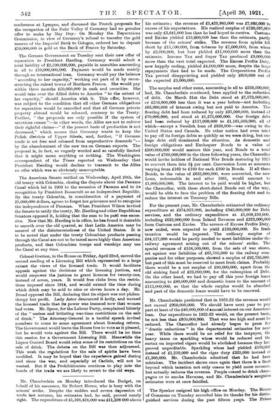The surplus and other sums, amounting in all to £259,500,000,
had, Mr. Chamberlain continued, been applied to the reduction of debt. On March 31st the Debt stood at £7,573,000,000, or £256,000,000 less than it was a year before—not including £65,000,000 of interest owing but not paid to America. The floating debt had been reduced by only £37,000,000, instead of £70,000,000, and stood at £1,275,000,000. Our foreign debt had been reduced by £117,000,000 to £1,161,560,000, all of which--except a Swedish loan of £826,000—was owing to the United States and Canada. No other nation had even tried to pay off its foreign debts so quickly as we were doing, but our huge debt still dominated the situation. As domestic and foreign obligations and Exchequer Bonds to a value of £300,000,000 would mature this year, and Bonds to a total value of £760,000,000 in the three following years, the Chancellor would invite holders of National War Bonds maturing by 1925 to convert them into 3i per cant. Conversion Loan at amounts varying from £183 to £160 for each £100 in Bonds. If all these Bonds, to the value of £632,000,000, were converted, the new Loan, redeemable in and after 1961, would amount to £1,000,000,000. The interest to be paid would be higher, but the Chancellor, with these short-dated Bonds out of the way, would be able to face the problem of the floating debt and to reduce the interest on Treasury Bills.


































 Previous page
Previous page